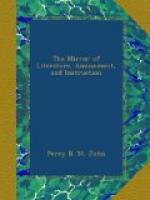* * * * *
TRIBUTES TO GENIUS.
The Cuts represent unostentatious yet affectionate tributes to three of the most illustrious names in literature and art: DANTE, and PETRARCH, the celebrated Italian poets; and CANOVA, whose labours have all the freshness and finish of yesterday’s chisel. Lord Byron, whose enthusiasm breathes and lives in words that “can never die,” has enshrined these memorials in the masterpiece of his genius. Associating Dante and Petrarch with Boccaccio, he asks:
But where repose the all Etruscan three—
Dante and Petrarch, and scarce
less than they,
The Bard of Prose, creative spirit! he
Of the Hundred Tales of Love—where
did they lay
Their tones, distinguish’d from
our common clay
In death as life? Are
they resolved to dust,
And have their country’s marbles
naught to say?
Could not their quarries furnish
forth one bust?
Did they not to her breast their filial
earth entrust?[10]
[Illustration: (Dante’s Tomb.)]
Dante was born at Florence in the year 1261. He fought in two battles, and was fourteen times ambassador, and once prior of the republic. Through one fatal error, he fell a victim to party persecution, which ended in irrevocable banishment. His last resting-place was Ravenna, where the persecution of his only patron is said to have caused the poet’s death. What an affecting record of gratitude! His last days at Ravenna are thus referred to by an accomplished tourist:[11]
“Under the kind protection of Guido Novello da Polenta, here Dante found an asylum from the malevolence of his enemies, and here he ended a life embittered with many sorrows, as he has pathetically told to posterity, ’after having gone about like a mendicant; wandering over almost every part to which our language extends; showing against my will the wound with which fortune has smitten me, and which is so often imputed to his ill-deserving, on whom it is inflicted.’ The precise time of his death is not accurately ascertained; but, it was either in July or September of the year 1321. His friend in adversity, Guido da Polenta, mourned his loss, and testified his sorrow and respect by a sumptuous funeral, and, it is said, intended to have erected a monument to his memory; but, the following year, contending factions deprived him of the sovereignty which he had held for more than half a century; and he, in his turn, like the great poet whom he had protected, died in exile. I believe, however, that the tomb, with an inscription purporting to have been written by Dante himself, of which I have here given an outline, was erected at the time of his decease: and, that his portrait, in bas-relief, was afterwards added by Bernardo Bembo, in the year 1483, who, at that time was a Senator and Podesta of the Venetian republic.”
Byron truly sings:




